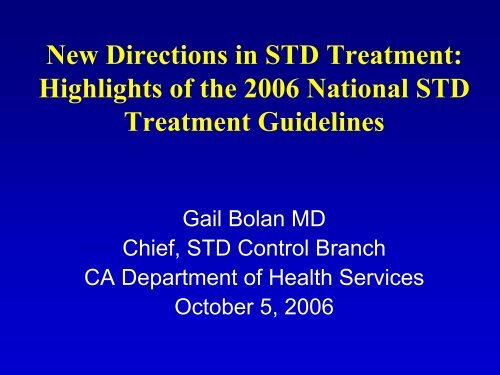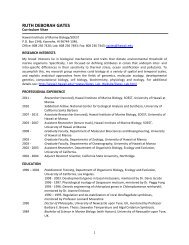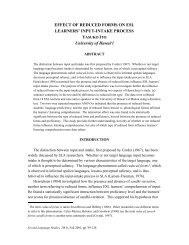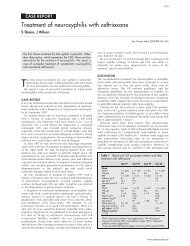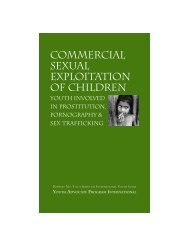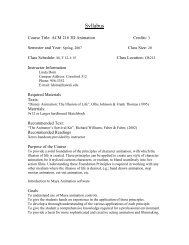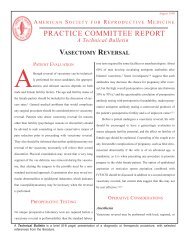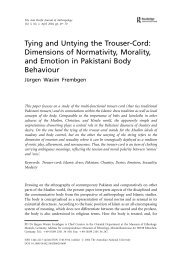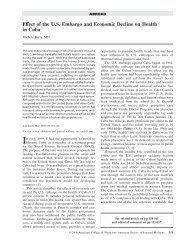New Directions In STD Treatment - University of Hawaii
New Directions In STD Treatment - University of Hawaii
New Directions In STD Treatment - University of Hawaii
Create successful ePaper yourself
Turn your PDF publications into a flip-book with our unique Google optimized e-Paper software.
<strong>New</strong> <strong>Directions</strong> in <strong>STD</strong> <strong>Treatment</strong>:<br />
Highlights <strong>of</strong> the 2006 National <strong>STD</strong><br />
<strong>Treatment</strong> Guidelines<br />
Gail Bolan MD<br />
Chief, <strong>STD</strong> Control Branch<br />
CA Department <strong>of</strong> Health Services<br />
October 5, 2006
Overview <strong>of</strong> Presentation<br />
� CDC <strong>STD</strong> treatment guidelines process<br />
� Proposed testing and treatment changes:<br />
�Prevention and Screening<br />
�Chlamydia and Gonorrhea<br />
�LGV<br />
�Genital ulcers: Syphilis, HSV<br />
�HPV<br />
�NGU, Cervicitis, PID<br />
�Vaginitis: Trich, BV, Yeast
CDC 2006 <strong>STD</strong> <strong>Treatment</strong><br />
Guidelines Development<br />
� Evidence-based on 4 outcomes <strong>of</strong> <strong>STD</strong> therapy<br />
� microbiologic cure, clinical cure, prevention <strong>of</strong><br />
sequelae and prevention <strong>of</strong> transmission<br />
� Recommended regimens preferred over<br />
alternative regimens<br />
� Alphabetized unless there is a priority <strong>of</strong> choice<br />
� Reviewed in April 2005<br />
� www.cdc.gov/std/treatment
Key<br />
Questions<br />
General Approach<br />
CDC <strong>STD</strong> <strong>Treatment</strong> Guidelines<br />
Enlistment <strong>of</strong><br />
Subject Matter<br />
Expert<br />
Systematic<br />
Review <strong>of</strong><br />
Evidence<br />
Background papers;<br />
Tables <strong>of</strong> evidence<br />
Guidelines<br />
Meeting 2005<br />
Experts in field<br />
as consultants<br />
Answer the “Key<br />
Questions”<br />
Rate the quality<br />
<strong>of</strong> the evidence<br />
Identify critical gaps<br />
in knowledge<br />
(research agenda)<br />
Write the<br />
Guidelines<br />
document
Challenging Management Dilemmas in the<br />
2006 <strong>STD</strong> <strong>Treatment</strong> Guidelines<br />
� Targeted screening, expedited partner treatment,<br />
re-testing after treatment for CT and GC<br />
� LGV emergence in MSM<br />
� Syphilis diagnosis with EIA and management in<br />
HIV-infected individuals<br />
� Antimicrobial resistance<br />
� GC, Syphilis and Trich<br />
� Age- and risk-based empiric treatment for cervicitis<br />
� Role <strong>of</strong> HSV serologic testing and suppressive<br />
therapy to prevent transmission
Prevention & Screening Issues<br />
� Sexual history taking and risk reduction counseling including<br />
the 5 P’s<br />
� Partners, Pregnancy prevention, Protection from <strong>STD</strong>s, Practices and<br />
Past History <strong>of</strong> <strong>STD</strong>s<br />
� Condom messages<br />
� Might reduce risk <strong>of</strong> developing PID and risk for transmission <strong>of</strong> HSV<br />
and HPV<br />
� Use <strong>of</strong> condoms with N-9 not recommended<br />
� Patents should be informed about which <strong>STD</strong>s they are<br />
tested for (and which not)<br />
� Emergency contraception should be available<br />
� Non-occupational PEP for HIV prevention as a result <strong>of</strong><br />
sexual exposure<br />
� Specials population: pregnant women, adolescents, MSM,<br />
WSW<br />
� Pap smear screening recommended according to national guidelines<br />
for WSW<br />
� Trich, BV, HPV and HIV <strong>of</strong> most concern in WSW
Sexual History Taking: The 5 P’s<br />
1. Partners<br />
� Do you have sex with men, women or both?<br />
� <strong>In</strong> the past 12 months how many partners have you had<br />
sex with?<br />
� <strong>In</strong> the past 2 months how many partners have you had<br />
sex with?<br />
2. Pregnancy prevention<br />
� Are you or your partner trying to get pregnant?<br />
� If no, What are you doing to prevent pregnancy?<br />
3. Protection from <strong>STD</strong>s<br />
� What do you do to protect yourself from <strong>STD</strong>s and HIV?
Sexual History Taking: The 5 P’s<br />
4. Practices<br />
� To understand your risks for <strong>STD</strong>s, I need to understand the kind <strong>of</strong> sex<br />
you have had recently.<br />
� Have you had vaginal sex, meaning penis in the vagina sex? If yes, do<br />
you use condoms never, sometimes or always?<br />
� Have you had anal sex, meaning penis in the rectum/anus/butt sex? If<br />
yes, do you use condoms never, sometimes or always?<br />
� Have you had oral sex, meaning mouth on penis/vagina/rectum sex? If<br />
yes, do you use condoms never, sometimes or always?<br />
� For condoms: if never: Why don’t you use condoms? If sometimes: <strong>In</strong><br />
what situations or with whom do you use or not use condoms?<br />
5. Past History <strong>of</strong> <strong>STD</strong>s<br />
� Have you ever Had an <strong>STD</strong>?<br />
� Have any <strong>of</strong> your partners had an <strong>STD</strong>?<br />
� Additional questions to identify HIV and Hepatitis risk<br />
� Have you or any <strong>of</strong> your partners ever injected drugs<br />
� Have you or any <strong>of</strong> your partners exchanged money or drugs for sex<br />
� Is there anything else about your sexual practices that I<br />
need to know about?
Recommend Nucleic Acid Amplification<br />
Tests for Detecting Chlamydia and<br />
� Highest sensitivity<br />
� Noninvasive<br />
Gonorrhea<br />
� Able to detect up to 40% more CT infections<br />
� Less dependent on specimen collection and handling<br />
� Urine and self-collected vaginal swabs<br />
� Non-clinical settings<br />
� Pelvic and genital exams not necessary<br />
� Clinic intake areas<br />
� Community based organizations<br />
� Home testing
<strong>STD</strong> Screening for Women<br />
� Adolescents & up to age 25<br />
� Annual chlamydia screening<br />
� Gonorrhea screening based on risk factors<br />
� Others <strong>STD</strong>s based on risk<br />
� HIV (?)<br />
� Women over 25 years <strong>of</strong> age<br />
� Based on risk factors<br />
� <strong>New</strong> or multiple sex partners<br />
� Prior history <strong>of</strong> <strong>STD</strong> or inconsistent use <strong>of</strong> barrier contraception<br />
� Pregnant women (first trimester)<br />
� HIV, Syphilis serology, Hep B sAg, and Chlamydia<br />
� Gonorrhea based on age and risk<br />
� Hep C based on risk<br />
� BV if high risk pregnancy
Percent Screened<br />
Estimated Chlamydia Screening Coverage<br />
(HEDIS) for Females Age 16-26<br />
USA and California, 1999-2004<br />
100<br />
90<br />
80<br />
70<br />
60<br />
50<br />
40<br />
30<br />
20<br />
10<br />
0<br />
1999 2000 2001 2002 2003 2004<br />
Natl MCO Natl Medicaid MediCal MC Cal HMO FPACT*<br />
*Family PACT program paid claims data
Chlamydia Screening in<br />
Heterosexual Males<br />
� Screening in heterosexual males not routinely<br />
recommended<br />
� Need evidence <strong>of</strong> reduction <strong>of</strong> infection in<br />
women to be cost effective<br />
� However, selective screening in high<br />
prevalence clinics (e.g. adolescent, corrections,<br />
<strong>STD</strong>) may be beneficial<br />
� Modeling suggests prevalence among males<br />
should be at least 6%*<br />
� CDC will develop separate guidance in this<br />
area*<br />
* Discussed at the<br />
2006 Guidelines Meeting
<strong>STD</strong> Screening for MSM<br />
<strong>STD</strong> Site Type <strong>of</strong> Sex<br />
HIV blood oral, anal<br />
Syphilis blood oral, anal<br />
GC/CT urethra or urine oral, anal<br />
GC/CT rectum receptive anal<br />
GC pharynx receptive oral<br />
HSV-2* blood<br />
* Some experts recommend<br />
FREQUENCY: At least at the initial visit then<br />
annually or more frequently based on risk
<strong>In</strong>dications for More Frequent<br />
Screening in MSM<br />
� <strong>In</strong>creased prevalence <strong>of</strong> STIs in area or patient<br />
population<br />
� Symptoms or recent history <strong>of</strong> any STI in patient<br />
or partner<br />
� Risky sexual behavior<br />
� Multiple or anonymous partners<br />
� Substance abuse especially methamphetamine<br />
� Risky sexual behavior in partner<br />
� If any <strong>of</strong> the above, then screen q 3-6 months<br />
MMWR 2003 52: RR 12
Prevalence <strong>of</strong> rectal chlamydia and<br />
gonorrhea by symptom status among MSM –<br />
San Francisco, 2003<br />
35%<br />
30%<br />
25%<br />
20%<br />
15%<br />
10%<br />
5%<br />
0%<br />
20.7%<br />
7.6%<br />
29.8%<br />
6.1%<br />
n=213 n=3579 n=212 n=3613<br />
Chalmydia Gonorrhea<br />
Symptomatic<br />
Asymptomatic<br />
Kent, CK et al. IS<strong>STD</strong>R, July 2005
Prevalence <strong>of</strong> urethral chlamydia and<br />
gonorrhea by symptom status among MSM –<br />
San Francisco, 2003<br />
35%<br />
30%<br />
25%<br />
20%<br />
15%<br />
10%<br />
5%<br />
0%<br />
15.1%<br />
2.7%<br />
26.9%<br />
0.8%<br />
n=213 n=3579 n=212 n=3613<br />
Chalmydia Gonorrhea<br />
Symptomatic<br />
Asymptomatic<br />
Kent, CK et al. IS<strong>STD</strong>R, July 2005
Prevalence <strong>of</strong> pharyngeal chlamydia and<br />
gonorrhea among MSM by clinic–<br />
San Francisco, 2003<br />
12%<br />
10%<br />
8%<br />
6%<br />
4%<br />
2%<br />
0%<br />
1.3%<br />
1.7%<br />
9.4%<br />
7.8%<br />
n=4658 n=719 n=4665 n=761<br />
Chalmydia Gonorrhea<br />
<strong>STD</strong> Clinic<br />
Gay Men's Health<br />
Kent, CK et al. IS<strong>STD</strong>R, July 2005
Proportion <strong>of</strong> unidentified CT and GC<br />
infections if only urine/urethral screening<br />
performed among MSM: San Francisco – 2003<br />
53%<br />
Chlamydia<br />
n = 574<br />
47%<br />
64%<br />
Identified Not Identified<br />
Gonorrhea<br />
n = 785<br />
36%<br />
Kent, CK et al. IS<strong>STD</strong>R, July 2005
C. trachomatis NAAT Testing<br />
…not FDA-cleared for rectal<br />
or pharyngeal specimens
Chlamydia <strong>Treatment</strong><br />
Adolescents and Adults<br />
Recommended regimens:<br />
� Azithromycin 1 g PO x 1<br />
� Doxycycline 100 mg PO BID x 7 d<br />
Alternative regimens:<br />
� Erythromycin base 500 mg PO QID x 7 d<br />
� Erythro ethylsuccinate 800 mg PO QID x 7 d<br />
� Ofloxacin 300 mg PO BID x 7 d<br />
� Lev<strong>of</strong>loxacin 500 mg PO QD x 7 d<br />
** NO CHANGES FOR 2006 GUIDELINES **
Chlamydia <strong>Treatment</strong> in Pregnancy<br />
Recommended regimens:<br />
� Azithromycin 1 g PO x 1*<br />
�Amoxicillin 500 mg PO TID x 7 d<br />
Alternative regimens:<br />
� Erythromycin base 500 mg PO QID x 7 d<br />
� Erythromycin base 250 mg PO QID x 14 d<br />
� Erythro ethylsuccinate 800 mg PO QID x 7 d<br />
� Erythro ethylsuccinate 400 mg PO QID x 14<br />
d<br />
Test <strong>of</strong> cure in 3-4 weeks<br />
*Preferrred Preferrred
Partner <strong>Treatment</strong> Options<br />
� Patient referral<br />
� Provider or clinic referral<br />
� Health department referral<br />
� Expedited Partner <strong>Treatment</strong> (EPT)<br />
�Patient-delivered partner therapy (PDPT)<br />
�Health department-delivered therapy<br />
�Pharmacy-delivered therapy
Percent<br />
16<br />
14<br />
12<br />
10<br />
<strong>In</strong>fection During Follow-up Among Patients<br />
Completing the EPT Trial<br />
8<br />
6<br />
4<br />
2<br />
0<br />
Standard care<br />
Expedited care<br />
10.6<br />
P=.02<br />
3.4<br />
13.2<br />
P=.17 P=.04<br />
10.8<br />
N=358 N=1595 N=1860<br />
Gonorrhea Chlamydia Gonorrhea or Chlamydia<br />
Golden et al., NEJM 2005; 352:676-85<br />
13<br />
9.9
Chlamydia and Gonorrhea Expedited<br />
Partner <strong>Treatment</strong><br />
� Expedited Partner <strong>Treatment</strong> (EPT) or Patient-<br />
Delivered Partner <strong>Treatment</strong> (PDPT)<br />
�Option for partner management for heterosexual<br />
men and women<br />
� Written materials should accompany medication and<br />
specially mention concern about PID in female<br />
partners<br />
�First line management is clinical evaluation<br />
�Not recommended in MSM because <strong>of</strong> concern<br />
regarding co-morbidities (e.g., HIV and other<br />
<strong>STD</strong>s)<br />
�CDC has developed separate guidance on<br />
EPT/PDPT
Provider Barriers to PDPT, CA 2002<br />
<strong>In</strong>complete care for partner*<br />
Dangerous without knowing hx*<br />
Practice not paid for<br />
May get me sued*<br />
Partners name must be provided<br />
Only for male partners<br />
*Significant predictors <strong>of</strong> no PDPT<br />
MD*<br />
NP<br />
0 20 40 60 80 100<br />
Strongly agree/agree (%)<br />
Data source: CA DHS <strong>STD</strong> Control Branch California Provider Survey
Recommendations for Chlamydia and<br />
Gonorrhea Re-Testing after <strong>Treatment</strong><br />
� Prefer “re-testing” to “re-screening”<br />
� High rates <strong>of</strong> re-infection after treatment and for<br />
GC may confer an elevated risk <strong>of</strong> PID<br />
� Consider re-testing <strong>of</strong> females; some experts<br />
suggest re-testing <strong>of</strong> males for CT and consider retesting<br />
<strong>of</strong> males for GC<br />
� Time frame: 3 months after treatment and for GC<br />
whenever seek care within 12 months if did not<br />
return at 3 months<br />
� No test <strong>of</strong> cure except in pregnant women with CT<br />
and for GC if treated initially with a fluoroquinolone<br />
and symptoms persist or recur after treatment
Gonorrhea Screening in Females<br />
� Based on US Preventive Services Task Force<br />
� Screening recommended for women under age<br />
25<br />
� Risk factors in older women include previous<br />
GC infection, other <strong>STD</strong>, new/multiple partners,<br />
inconsistent condom use, commercial sex, drug<br />
use<br />
� CA GC Screening Guidelines recommend:<br />
� history <strong>of</strong> gonorrhea in past two years<br />
� multiple partners (>1 in past year)<br />
� partner with other partners<br />
� African American women up to age 30
for patients with gonorrhea in California…
Percent <strong>of</strong> Neisseria gonorrhoeae Isolates with<br />
Decreased Susceptibility or Resistance to Cipr<strong>of</strong>loxacin,<br />
California GISP, 1996–2004<br />
GC Rate per 100,000<br />
80<br />
60<br />
40<br />
20<br />
0<br />
<strong>In</strong>termediate<br />
Resistant<br />
State GC Rate<br />
1996 1997 1998 1999 2000 2001 2002 2003 2004<br />
YEAR<br />
28<br />
24<br />
20<br />
16<br />
12<br />
8<br />
4<br />
0<br />
Percent
Gonorrhea – <strong>Treatment</strong> Issues<br />
� Fluoroquinolones NOT recommended for:<br />
� Acquisition in CA or <strong>Hawaii</strong> or other areas with high<br />
prevalence <strong>of</strong> FQ resistance<br />
� MSM<br />
� Any foreign acquisition- Europe, Middle East, Asia,<br />
Pacific<br />
� Limited options in cephalosporin allergic<br />
patients:<br />
� Spectinomycin is no longer manufactured<br />
� CDC recommends desensitization*<br />
� Could be a special case to consider azithromycin*<br />
* Discussed at the<br />
2006 Guidelines Meeting
Gonorrhea <strong>Treatment</strong> <strong>of</strong> Urogenital<br />
<strong>In</strong>fections if Fluoroquinolone Resistance<br />
Recommended regimens:<br />
� Ceftriaxone 125 mg IM x 1*<br />
� Cefixime 400 mg PO x 1*<br />
Alternative regimens:<br />
� Spectinomycin 2 g IM x 1**<br />
� Single-dose cephalosporin regimens<br />
� Cefpodoxime 400 mg po x 1<br />
� Cefuroxime 1 g po x 1<br />
Azithromycin 2 gm is not recommended by CDC<br />
Co-treat for chlamydia unless ruled out by NAAT<br />
* suspension may be available<br />
** currently not manufactured<br />
*Preferred and only recommended<br />
regimen for pharyngeal infection
California Enhanced Gonorrhea Data<br />
Any Fluroquinolone Use by Health Jurisdiction<br />
- 2004<br />
Use <strong>of</strong><br />
Fluroquinolones<br />
Alameda 5%<br />
Fresno 6%<br />
Kern 12%<br />
Long Beach 11%<br />
Orange 12%<br />
San Bernardino 8%<br />
Santa Clara 21%
Lymphogranuloma Venereum<br />
(LGV)<br />
C. trachomatis serovars L1, L2, L3<br />
� Clinical presentation<br />
� Lymphadenopathy syndrome: ulcer & inguinal<br />
adenopathy (bubo)<br />
� Anorectal syndrome: proctitis/protocolitis<br />
� Mucoid/hemorrhagic rectal discharge, anal pain,<br />
constipation, tenesmus<br />
� Complications from destructive granulomatous<br />
process<br />
�abscesses with scarring, fistulae, strictures,<br />
genital elephantiasis
LGV Issues<br />
� LGV has been around for some time<br />
� May be asymptomatic<br />
� Clinical presentation typically includes protocolitis<br />
in MSM<br />
� Consider GC and HSV in differential<br />
� Diagnosis is primarily by clinical findings/history<br />
� Test for rectal CT<br />
� Swabs <strong>of</strong> rectal lesions visualized by anoscopy is<br />
better than blind rectal swab<br />
� CDC can do molecular testing <strong>of</strong> suspect rectal swabs<br />
/ lesions (404-639-2059)<br />
� Role <strong>of</strong> serologic testing is less clear
LGV Proctocolitis:<br />
Serologic Diagnosis<br />
� Microimmun<strong>of</strong>luorescence (MIF)<br />
� species-specific test<br />
� titer ≥ 1:256 is suggestive (arbitrary cut point)<br />
� Complement Fixation (CF)<br />
� genus-specific<br />
� positive 2 weeks after infection<br />
� titer ≥ 1:64 suggestive <strong>of</strong> LGV<br />
� high background rate <strong>of</strong> low titer reactors
LGV Proctocolitis:<br />
<strong>Treatment</strong> Issues<br />
� Presumptive treatment for LGV based on clinical<br />
suspicion along with other empiric treatment for<br />
protocolitis: (Ceftriaxone 125 mg IM plus)<br />
Recommended regimen:<br />
�Doxycycline 100 mg PO BID x 21 days<br />
Alternative regimen:<br />
�Erythromycin base 500 mg PO QID x 21 days<br />
Likely effective but clinical data lacking:<br />
�Azithromycin 1 g PO weekly for 3 weeks<br />
• Partners within past 60 days <strong>of</strong> onset <strong>of</strong> symptoms need<br />
evaluation. If no symptoms, treat with:<br />
Azithromycin 1 g or Doxycycline 100 mg BID x 7 days
Phil and the Penis on the Go
Syphilis<br />
Treponema pallidum
The Three “R”s <strong>of</strong> Syphilis<br />
� Recognize<br />
� Rx<br />
� Report
Syphilis Issues<br />
� Diagnostic issues<br />
� Criteria for diagnosing early latent is change to be<br />
consistent with the surveillance case definition<br />
� <strong>New</strong> EIA testing algorithms:<br />
� reflexive quantitative RPR/VDRL<br />
� alternative treponemal test for discrepancies<br />
� FP in low risk populations<br />
� Some experts recommend CSF exam for<br />
� All patients with latent syphilis and RPR ≥ 1:32<br />
� HIV-infected patients with latent syphilis and CD4 count ≤<br />
350<br />
� Recommend against the use <strong>of</strong> azithromycin<br />
� Note penicillin usage problems<br />
� BIC shortage<br />
� Specify use <strong>of</strong> Bicillin L-A (NOT Bicillin C-R)
Latent Syphilis<br />
� No clinical manifestations: only evidence is<br />
positive serologic tests<br />
� Divided into two stages for treatment purposes<br />
�Early latent syphilis: 1yr duration<br />
* Could be treatment failure
Diagnostic Tests for Syphilis<br />
� Darkfield / DFA-TP<br />
� PCR<br />
� VDRL/RPR<br />
� FTA-abs / TP-PA (MHA-TP)<br />
� EIA
Syphilis EIA Tests<br />
�Treponemal test but test performance may be<br />
inferior to TP-PA (Captia and TrepChek)<br />
� Specificity concerns<br />
�Can be used for screening but if positive then<br />
need quantitative RPR/VDRL<br />
�Advantages if comparable sensitivity and<br />
specificity<br />
� Not miss prozones<br />
� Low cost<br />
�Both IgM and IgG tests available<br />
� No clinical value <strong>of</strong> IgM in adult syphilis diagnosis
28,366*<br />
Non-reactive (NR)<br />
275**<br />
Syphilis EIA Trep- Chek Testing<br />
Algorithm: Southern Kaiser<br />
<strong>In</strong>itial<br />
EIA<br />
Not<br />
Syphilis<br />
Non-reactive (NR)<br />
TP-PA<br />
Reactive (R)<br />
Reactive (R) or Equivocal (Eq) Repeat EIA<br />
(in duplicate)<br />
366<br />
Non-reactive (NR)<br />
Non-reactive (NR)<br />
RPR<br />
Reactive (R)<br />
740<br />
Reactive (R) or Equivocal (Eq)<br />
* Nov- Dec 2004<br />
Titer RPR<br />
** 1 <strong>of</strong> 192 EIA +/RPR -/TP-PA -<br />
Syphilis<br />
confirmed by CDC Immunoassay Novak et al, ASM 2006
Criteria for CSF Examination<br />
� Neurologic or ophthalmic symptoms/signs<br />
� Evidence <strong>of</strong> tertiary disease<br />
� aortitis, gumma, iritis<br />
� <strong>Treatment</strong> failure<br />
� HIV infection with late latent or latent <strong>of</strong> unknown<br />
duration<br />
� Some experts recommend a CSF exam in all<br />
patients with latent syphilis and an RPR titer<br />
≥ 1:32 and HIV-infected patients with CD4<br />
count ≤ 350
Proposed Criteria for Performing LP in<br />
HIV-<strong>In</strong>fected Patients with <strong>New</strong>ly<br />
Diagnosed Syphilis<br />
Stage <strong>of</strong> Syphilis<br />
Primary or early latent<br />
with RPR ≤ 1:32<br />
Any stage with RPR >1:32<br />
Late-latent or syphilis <strong>of</strong><br />
unknown duration<br />
Positive RPR/confirmatory test<br />
with neurologic or ophthalmic<br />
symptoms and/or signs<br />
CD4-Cells Recommendation<br />
≥350<br />
Syphilis Resistant to Azithromycin!
Syphilis <strong>Treatment</strong><br />
Primary, Secondary & Early Latent<br />
Recommended regimen for adults:<br />
� Benzathine penicillin G 2.4 million units IM<br />
in a single dose<br />
Alternatives (non-pregnant penicillin-allergic<br />
adults):<br />
� Doxycycline 100 mg po bid x 2 weeks<br />
� Tetracycline 500 mg po qid x 2 weeks<br />
� Ceftriaxone 1 g IV or IM qd x 8-10 d<br />
� Azithromycin 2 g po in a single dose
HSV Issues<br />
� Role <strong>of</strong> type-specific HSV<br />
serologic tests<br />
� Role <strong>of</strong> suppressive therapy to<br />
reduce transmission
Genital Herpes – Testing Issues<br />
� Glycoprotein G type-specific HSV-2 serology<br />
tests may be useful HSV-2 (HerpeSelect- 1 or 2 ELISA,<br />
HerpeSelect- 1 and 2 Immunoblot and HSV-2 ELISA, Biokit HSV-2, and<br />
SureVue HSV-2):<br />
� Recurrent/atypical symptoms with negative culture<br />
� Clinical diagnosis without lab confirmation<br />
� Patients with a partner with genital HSV<br />
� Some experts recommend serology tests:<br />
� As part <strong>of</strong> “comprehensive <strong>STD</strong> evaluation” in high risk<br />
individuals such a those with multiple partners, HIVinfected,<br />
MSM with high HIV risk<br />
� <strong>In</strong> pregnant women with no history <strong>of</strong> HSV and a<br />
partner with history <strong>of</strong> symptomatic HSV<br />
� Universal screening NOT recommended
Rates <strong>of</strong> Transmission <strong>of</strong> HSV-2 to Susceptible Partners<br />
is Reduced with Once-Daily Suppressive Therapy<br />
• 1484 heterosexual couples<br />
randomly assigned to take 500 mg<br />
<strong>of</strong> valacyclovir or placebo once<br />
daily for 8 months<br />
• Serum samples collected monthly<br />
from susceptible partners for HSV<br />
analysis<br />
• The valacyclovir group showed<br />
• decreased transmission<br />
• lower frequency <strong>of</strong> shedding<br />
• fewer copies <strong>of</strong> HSV-2 DNA<br />
when shedding occurred<br />
Percent Transmission<br />
4<br />
3.5<br />
3<br />
2.5<br />
2<br />
1.5<br />
1<br />
0.5<br />
0<br />
1.9%<br />
Valacyclovir<br />
Group<br />
(N=743)<br />
3.6%<br />
Control<br />
Group<br />
(N=741)<br />
Corey et al, NEJM 2004; 350:11-20
Genital Herpes – <strong>Treatment</strong> Issues<br />
� <strong>In</strong>itial <strong>In</strong>fection<br />
� Treat because may develop severe or prolonged symptoms later<br />
� Established <strong>In</strong>fection<br />
� Suppressive therapy discussed first as if preferred over episodic therapy<br />
for both HIV negative and positive individuals with recurrent outbreaks<br />
� Benefits <strong>of</strong> suppressive therapy now include reducing risk <strong>of</strong><br />
transmission in addition to clinical benefit <strong>of</strong> decreasing symptoms and<br />
recurrences<br />
� <strong>In</strong>dication for suppressive therapy to reduce transmission include:<br />
� Discordant heterosexual couples where the partner has a hx <strong>of</strong> genital HSV<br />
� Persons with multiple partners including MSM<br />
� Persons who are HSV-2 seropositive without a history <strong>of</strong> genital HSV<br />
� No studies in discordant pregnant couples<br />
� Options <strong>of</strong> suppression and episodic therapy should be discussed<br />
� Higher doses <strong>of</strong> antivirals not recommended for rectal and oral<br />
infections
Genital Herpes – <strong>Treatment</strong> Issues<br />
� <strong>In</strong>itial <strong>In</strong>fection<br />
� No change in treatment recommendations<br />
� Suppressive therapy<br />
� No change in treatment recommendations<br />
� Episodic <strong>Treatment</strong> for recurrence:<br />
� ADDED Acyclovir 800 mg PO TID for 2 days<br />
� Famciclovir 1000 mg PO BID for 1 day<br />
� Valacyclovir 500 mg PO BID for 3 days<br />
� DELETED Acyclovir 200 mg PO 5 x a day for 5<br />
days<br />
� For Persons with HIV<br />
� No change for suppressive or episodic except<br />
deleted acyclovir 200 mg PO 5 x a day for 5-10<br />
days
HPV Issues<br />
� Clarify uses <strong>of</strong> HPV DNA test<br />
� No change in diagnosis or treatment <strong>of</strong><br />
external genital warts<br />
� No discussion <strong>of</strong> HPV vaccine
HPV Issues<br />
� Clarify uses <strong>of</strong> HPV DNA test in women<br />
� No recommendations regarding HPV<br />
testing and anal Pap smears in MSM or<br />
HIV-infected patients<br />
� No change in diagnosis or treatment <strong>of</strong><br />
external genital warts<br />
� No discussion <strong>of</strong> HPV vaccine
Clinical <strong>In</strong>dications for HPV DNA<br />
Testing<br />
Proven to be clinically useful for:<br />
� Triage <strong>of</strong> ASCUS Pap smears<br />
� Adjunct screening in women age 30 and over<br />
� 12-month f/u <strong>of</strong> LSIL in adolescents<br />
� Post-colposcopy and post-treatment follow-up<br />
NO proven benefit for:<br />
� Triage <strong>of</strong> ASC-H, LSIL in adults or higher grade<br />
lesions<br />
� <strong>STD</strong> screening in the general population<br />
� Evaluation <strong>of</strong> sex partners<br />
� Evaluation <strong>of</strong> genital warts
Issues Regarding Anal Cancer Screening in<br />
MSM or HIV-infected patients<br />
� Anal HPV DNA is prevalent so role <strong>of</strong> HPV testing in<br />
anal cancer screening is unclear<br />
� Little data on the natural history <strong>of</strong> anal SILs<br />
� Questions regarding reliability <strong>of</strong> screening methods<br />
� <strong>In</strong>consistent correlation between anal Paps and histology<br />
� <strong>In</strong>traobserver variability in interpretation <strong>of</strong> anal Pap smears<br />
� Limited data on treatment efficacy and side effects<br />
� If clinicians are conducting anal cancer screening, then<br />
collecting useful data to inform screening<br />
recommendations is recommended
Nongonococcal<br />
Urethritis Issues<br />
� <strong>New</strong> etiologic agent: Mycoplasma genitalium<br />
� No change in diagnostic criteria<br />
� Treat for CT; azithromycin efficacy better for Mg<br />
� Recurrent/persistent NGU:<br />
� Consider trichomoniasis, prostatitis, non-infectious<br />
etiologies<br />
� Treat with metronidazole PLUS azithromycin if not<br />
used for initial infection<br />
� DELETED erythromycin for treating recurrent NGU
Cervicitis –<br />
Diagnostic Issues<br />
� Changed name from mucopurulent cervicitis (MPC)<br />
to cervicitis<br />
� M. genitalium, BV and douching may play a role in<br />
addition to CT, GC, trichomoniasis and HSV<br />
� Diagnostic criteria: endocervical mucopus OR<br />
cervical friability<br />
� Diagnosis:<br />
� Vaginal wet mount with >10 WBCs per HPF associated<br />
with CT and GC infection<br />
� Evaluate for PID, BV and trichomoniasis (culture if<br />
wet mount is negative) in addition to CT and GC
Cervicitis – <strong>Treatment</strong> Issues<br />
� <strong>New</strong> age- and risk-based empiric treatment<br />
� Presumptive treatment for CT:<br />
� Age 25 or younger<br />
� <strong>STD</strong> risk in older women: new/multiple partners,<br />
unprotected sex<br />
� Especially if follow-up unlikely or non-NAAT test<br />
used<br />
� Presumptive treatment for GC:<br />
� High prevalence (>5%)<br />
� Treat BV if present
Pelvic <strong>In</strong>flammatory Disease Issues<br />
� <strong>New</strong>est etiologic agent: Mycoplasma genitalium<br />
� Pathogenesis unclear<br />
� No recommendation for Mg testing<br />
� If no evidence <strong>of</strong> cervicitis and no WBCs on wet<br />
mount the diagnosis <strong>of</strong> PID is unlikely<br />
� Modify minimal criteria for presumptive treatment:<br />
� CMT OR uterine tenderness OR adnexal tenderness<br />
� Clarify use <strong>of</strong> metronidazole*:<br />
� <strong>Treatment</strong> to cover anarobes should be considered<br />
� If BV is present or cannot be ruled out, add<br />
metronidazole*<br />
� Azithromycin treatment mentioned “outside the box”<br />
* Discussed at the<br />
2006 Guidelines Meeting
Proposed PID: Oral<br />
<strong>Treatment</strong> Regimens *<br />
Recommended Regimens *:<br />
�Ofloxacin 400 mg PO BID** x 14 d<br />
�Lev<strong>of</strong>loxacin 500 mg PO QD x 14 d<br />
�Ceftriaxone 250 mg IM (or other parenteral<br />
3rd generation cephalosporin) x 1<br />
plus<br />
Doxycycline 100 mg PO BID x 14 d<br />
�Cefoxitin 2 g IM and probenecid 1 g PO x 1<br />
plus<br />
Doxycycline 100 mg PO BID x 14 d<br />
* Plus metronidazole if BV or BV cannot be ruled out<br />
** typo in guidelines- guidelines once daily<br />
* Discussed at the<br />
2006 Guidelines Meeting
PID: Oral <strong>Treatment</strong><br />
Regimens<br />
Oral regimen A:<br />
�Ofloxacin* 400 mg PO BID** x 14 d or<br />
�Lev<strong>of</strong>loxacin* 500 mg PO QD x 14 d<br />
plus (with or without)<br />
�Metronidazole 500 mg PO BID x 14 d<br />
*Contraindicated pregnant or nursing women and in CA, if<br />
GC documented and flouroquinolone is used need TOC<br />
** typographical error in guidelines- not once daily
PID: Oral <strong>Treatment</strong> Regimens<br />
Continued<br />
Oral regimen B:<br />
�Ceftriaxone 250 mg IM (or other parenteral<br />
3rd generation cephalosporin) x 1 or<br />
�Cefoxitin 2 g IM and probenecid 1 g PO x 1<br />
plus<br />
�Doxycycline* 100 mg PO BID x 14 d<br />
with or without<br />
�Metronidazole 500 mg PO BID x 14 d<br />
*Contraindicated pregnant or nursing women
Vaginitis<br />
Trichomonas<br />
Bacterial Vaginosis<br />
Vulvovaginal Candidiasis
Trichomoniasis Issues<br />
� Diagnosis on Pap test lacks specificity; recommend<br />
confirm with culture if patient is at low risk<br />
� <strong>New</strong> point <strong>of</strong> care tests have better sensitivity but FP<br />
in lower prevalence population<br />
� OSOM Trichomonas Rapid Test and Affirm TM VP III<br />
� Culture is the most sensitive and specific and should<br />
be done if wet mount is negative and Trichomoniasis<br />
is suspected<br />
� <strong>New</strong> treatment:<br />
� ADD tinidazole 2 g po x 1<br />
� Higher cost but better tolerated<br />
� <strong>New</strong> management <strong>of</strong> treatment failure (after metro 2 g<br />
po x 1) and Metronidazole-resistant trichomonas
Tinidazole: A <strong>New</strong> <strong>Treatment</strong><br />
Option<br />
� Second generation 5-nitroimidazole<br />
�92%-100% effectiveness for trichomoniasis<br />
�Contraindicated in pregnancy (category C)<br />
� Advantages versus Metronidazole<br />
� Greater tolerability (approx. ½ incidence <strong>of</strong> nausea,<br />
vomiting and other GI side effects)<br />
� Longer duration <strong>of</strong> action (t1/2 <strong>of</strong> 12-14 hrs vs 6-7 hrs)<br />
� Greater in vitro potency against protozoa and anaerobes<br />
� Effective in metronidazole-resistant trichomoniasis<br />
� 92% (22/24) cure rate in largest report<br />
� Enhanced penetration in genital tissues
Trichomoniasis <strong>Treatment</strong><br />
Recommended regimen:<br />
� Metronidazole 2 g PO x 1<br />
� Tinidazole 2 g po x 1<br />
Alternative regimen:<br />
� Metronidazole 500 mg PO BID x<br />
7d<br />
Recommended regimen in pregnancy:<br />
� Metronidazole 2 g PO x 1<br />
� Pregnancy category B and Tinidazole<br />
is category C
Proposed Management Trichomoniasis<br />
<strong>Treatment</strong> Failure<br />
� Re-treat with: Metronidazole 500 mg po<br />
BID x 7 d or Tinidazole 2 g po x 1<br />
� If repeat failure, treat with: Metronidazole<br />
or Tinidazole 2 g po x 5 d<br />
� Some experts treat with: Tinidazole 2-3 g<br />
po x 14 d*<br />
� Susceptibility testing: Send isolate to CDC<br />
�707-488-4115 or www.cdc.gov/std for<br />
instructions<br />
* Discussed at the<br />
2006 Guidelines Meeting
Bacterial Vaginosis – <strong>Treatment</strong><br />
� <strong>Treatment</strong>:<br />
Issues<br />
� Clindamycin cream may be less effective than<br />
metronidazole<br />
� DELETED metronidazole 2 g single dose alternative<br />
� Suppressive treatment:<br />
� ADDED metronidazole gel twice weekly<br />
� <strong>Treatment</strong> <strong>of</strong> BV in pregnancy:<br />
� Metronidazole 500 mg po BID in addition to 250 mg po<br />
TID<br />
� Pre-surgical screening and treatment<br />
� Benefit for hysterectomy and surgical abortion<br />
� Consider for other procedures
BV <strong>Treatment</strong><br />
Recommended regimens:<br />
� Metronidazole 500 mg PO BID x 7 d *<br />
� Metronidazole gel 0.75% 5 g per vagina QD/BID x 5<br />
d<br />
� Clindamycin cream 2% 5 g per vagina QHS x 7 d<br />
Alternative regimens:<br />
� Clindamycin 300 mg PO BID x 7 d<br />
� Clindamycin ovules 100 mg per vagina QHS x 3 d<br />
Recommended regimens in pregnancy:<br />
� Metronidazole 500 mg PO BID x 7 days<br />
� Metronidazole 250 mg PO TID x 7 days<br />
� Clindamycin 300 mg PO BID x 7 days<br />
Suppressive treatment:<br />
� Metronidazole gel 0.75% twice weekly for 6<br />
* months<br />
Preferred
Vulvovaginal Candidiasis<br />
� Uncomplicated versus Complicated VVC<br />
� <strong>In</strong>travaginal treatment:<br />
�ADD miconazole 1200 mg vaginal<br />
suppository x 1 day (over the counter)<br />
� <strong>Treatment</strong> for recurrent VVC:<br />
�<strong>In</strong>duction with fluconazole 100/150/200 mg<br />
PO q 72 h x 3, then maintenance with<br />
fluconazole 100/150/200 mg PO q week
<strong>STD</strong> Resources<br />
California <strong>STD</strong>/HIV Prevention Training<br />
Center<br />
� www.stdhivtraining.org<br />
National Network <strong>of</strong> <strong>STD</strong>/HIV Prevention<br />
Training Centers<br />
� www.stdhivpreventiontraining.org<br />
CDC <strong>Treatment</strong> Guidelines<br />
� www.cdc.gov/std/treatment


